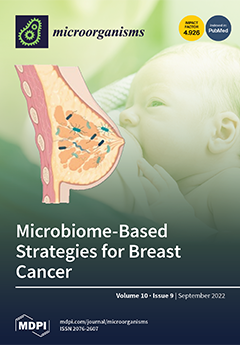In the present work, the profiles of bacterial communities of whole and filleted European sea bass (
Dicentrarchus labrax), during several storage temperatures (0, 4, 8 and 12 °C) under aerobic and Modified Atmosphere Packaging (MAP) conditions, were examined via the 16S
[...] Read more.
In the present work, the profiles of bacterial communities of whole and filleted European sea bass (
Dicentrarchus labrax), during several storage temperatures (0, 4, 8 and 12 °C) under aerobic and Modified Atmosphere Packaging (MAP) conditions, were examined via the 16S rRNA High-Throughput Sequencing (HTS) approach. Sensorial attributes were also assessed to determine products’ shelf-life. Results indicated that shelf-life was strongly dependent on handling, as well as on temperature and atmosphere conditions. HTS revealed the undisputed dominance of
Pseudomonas from the very beginning and throughout storage period in the majority of treatments. However, a slightly different microbiota profile was recorded in MAP-stored fillets at the middle stages of storage, which mainly referred to the sporadic appearance of some bacteria (e.g.,
Carnobacterium,
Shewanella, etc.) that followed the dominance of
Pseudomonas. It is noticeable that a major difference was observed at the end of shelf-life of MAP-stored fillets at 12 °C, where the dominant microbiota was constituted by the genus
Serratia, while the relative abundance of
Pseudomonas and
Brochothrix was more limited. Furthermore, at the same temperature under aerobic storage of both whole and filleted fish,
Pseudomonas almost co-existed with
Acinetobacter, while the presence of both
Erwinia and
Serratia in whole fish was noteworthy. Overall, the present study provides useful information regarding the storage fate and spoilage status of whole and filleted European sea bass, suggesting that different handling and storage conditions influence the shelf-life of sea bass by favoring or delaying the dominance of Specific Spoilage Organisms (SSOs), affecting in parallel to some extent the formation of their consortium that is responsible for products’ sensorial deterioration. Such findings enrich the current knowledge and should be used as a benchmark to develop specific strategies aiming to delay spoilage and thus increase the products’ added value.
Full article






